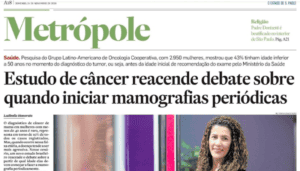Last Sunday, the 24th, the Jornal The State of S. Paulo published in its printed version and web an article about a cancer study that reignites the debate about periodic mammograms. The study was conducted by the Latin American Group of Cooperative Oncology (LACOG, its acronym in English), a non-governmental organization that brings together 147 researchers from 70 institutions, together with the Brazilian Group for the Study of Breast Cancer and support from the Avon Institute. The work began in 2016 and the participants will be followed up until 2021 to evaluate treatments, surgeries, possible recurrence of the disease and survival rate.
The article points out that the diagnosis of breast cancer in women under 40 is rare, representing around 10% of all registered cases. But when it occurs in this age group, the disease tends to be more aggressive. In this scenario, a new Brazilian study reignites the debate about what age they should start having mammograms periodically.
At the end, it quotes some data from the “Profile of the Physician Specialist in Radiology and Imaging Diagnosis”, carried out by CBR in partnership with FMUSP and launched earlier this year, showing that, in the Unified Health System (SUS), with 2,102 devices available in the country, the State of São Paulo is the most privileged (402 mammography devices) while Amapá has the largest deficit (with two, ideally three).
Click here to read.




